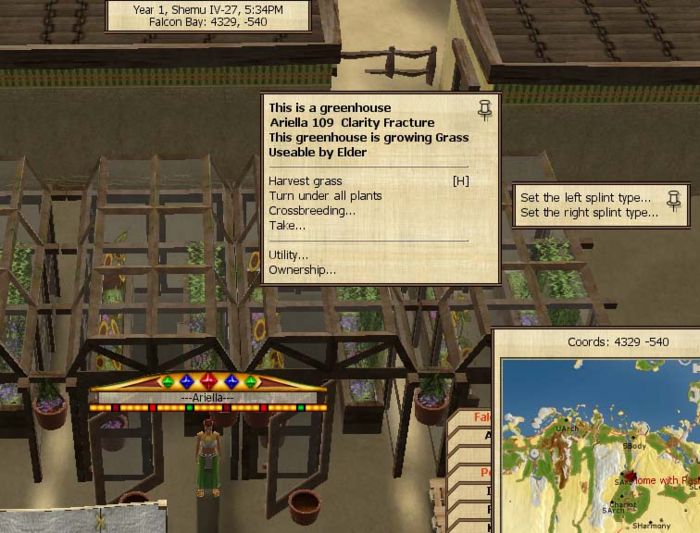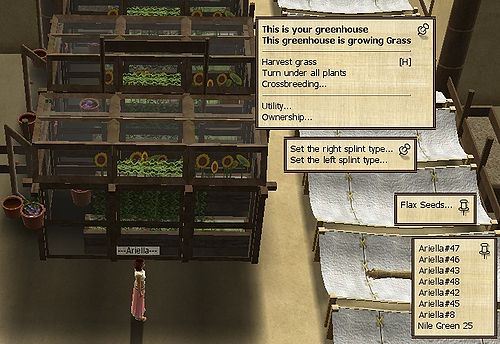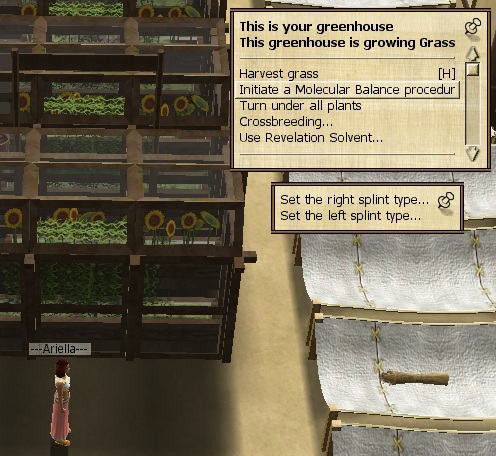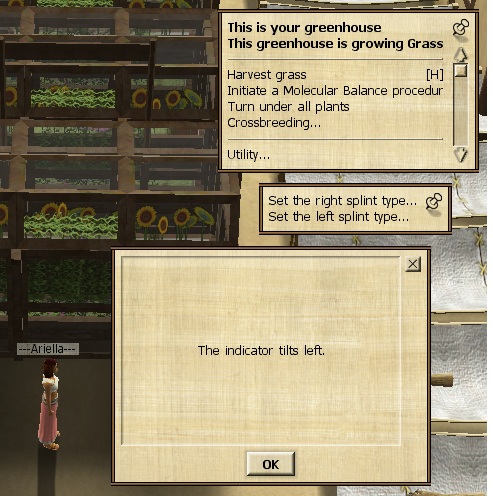The Wiki for Tale 6 is in read-only mode and is available for archival and reference purposes only. Please visit the current Tale 11 Wiki in the meantime.
If you have any issues with this Wiki, please post in #wiki-editing on Discord or contact Brad in-game.
Difference between revisions of "Crossbreeding and Hints"
| (11 intermediate revisions by the same user not shown) | |||
| Line 24: | Line 24: | ||
==Length, Elongation and Shortening of the Genome== | ==Length, Elongation and Shortening of the Genome== | ||
| − | Sometimes a gene is added or eliminated at the splice point. If a gene is added, it will always be a doubled gene just left or right of the splice point. Statistics (90 experiments) show an approximate chance of 25% to get an elongation and 25% to get a shortening.<br> | + | Sometimes a gene is added or eliminated at the splice point after crossbreeding. If a gene is added, it will always be a doubled gene just left or right of the splice point. Statistics (90 experiments) show an approximate chance of 25% to get an elongation and 25% to get a shortening.<br> |
The genome length of the crossbred plant is by default the average length '''rounded up''' of the parents' genome. The rounding up on odd genome length sums is based on 20 tests that gave 10 results with rounded up average length, along with 3 results with 1 more gene (doubled gene at splice point) and 7 results with 1 less gene (eliminated gene at splice point).<br> | The genome length of the crossbred plant is by default the average length '''rounded up''' of the parents' genome. The rounding up on odd genome length sums is based on 20 tests that gave 10 results with rounded up average length, along with 3 results with 1 more gene (doubled gene at splice point) and 7 results with 1 less gene (eliminated gene at splice point).<br> | ||
| − | + | '''USING MOLECULAR BALANCE''' | |
| − | + | [[Image:Molecular_Balance_Splints.jpg | 500 px | Setting Plants into each Splint]] | |
| + | |||
| + | The tech, Molecular Balance, tests the genome 'weight' (weight being the genome length)of one plant against the genome 'weight' of a second plant. Put a plant in each of the Left and Right Splints in a [[Greenhouse]] that you want to test and see which genome is smaller or greater in genome length. This test is useful when 'breeding down' (deliberately shortening) a plant genome or 'breeding up' (deliberately elongating) a plant genome | ||
| + | |||
| + | [[Image:Molecular_Balance_Initiation.jpg | 500 px | Initiating the Molecular Balance Test]] | ||
| + | |||
| + | Measure the genome 'weights' of the two plants against each other by clicking on 'Initiating with Molecular Balance' making sure to have a King's Coin and [[Revelation Solvent|Revelation Solvent - Crystal]] in your inventory as ingredients to trigger the Molecular Balance. | ||
| + | |||
| + | [[Image:Molecular_Balance_Test_Results.jpg | 500 px | Setting Plants into each Splint]] | ||
| + | |||
| + | There are three results that can happen: | ||
| + | * The indicator tilts left. | ||
| + | * The indicator tilts right. | ||
| + | * The indicator remains in the middle. | ||
| + | The indicator tilts toward the plant genome with the lesser amount of genes. If the indicator does not tilt then both plant genomes have the same number of genes. | ||
==Fun Sea Lily Breeding Hints== | ==Fun Sea Lily Breeding Hints== | ||
Latest revision as of 21:15, 14 August 2011
Doing a Crossbreed and Suggestions
Cross Breeding for Tale 4 can be used on flax, flowers (Sea Lilies, Roses) vines, and wheat in a greenhouse. The tech is received from a University of Thought. Look under Techs Cross Breeding to see which regions have opened Cross Breeding.
Click on the greenhouse to find the "Crossbreeding..." option.
Note: With Tale 4 labeling of greenhouses was added under Utilities. It is 'highly' recommended to use this with some notation such as "#34 Fracture Energy" and record the cross on another page for later reference.
You may place two differently named plants (see note later to get around this exclusion) of the same type and species, one in the left cross and one in the right cross. For example, a sea lily cannot be crossed with an orchid, and neither can two different seasonal wheat types be crossed. If there is a plant in the left or right cross already, you will get the message "The left/right splint is already satured with whatever. Scrape away these seed and replace with whatever?". This can be handy if you have forgotten which plants are in the left and right crosses, say after you have been using solvents. If you would like to breed the same named plants you may go to any University of Worship (after gaining the Seed Registry tech at a University of Leadership) and rename a plant variety.
Make sure you have Nut's Essence in your Items, refresh the cross breeding window and click on "Initiate the Cross". A message in Main will tell you that it will take 15 minutes for the cross to finish. After 15 minutes another message will tell you that the cross is finished and which #number it is. The plants used in the splints will be consumed.
One child bulb or seed will be formed by taking a certain number of genes from the left side of the genome of the Left Cross and grafting it on to a certain number of genes taken from the right side of the genome of the Right Cross.
Example with Sea Lilies:
Fracture Left Cross ROYGROYGYORGORGOOO
Vampire Right Cross IYIYIOIYIOIO
Child Bulb (might grab from Fracture) ROYGROYG + OIYIOIO (from Vampire)
So if you understand what those genes and gene sets do in a genome you can make more intelligent crossbreeds for what your target is.
Length, Elongation and Shortening of the Genome
Sometimes a gene is added or eliminated at the splice point after crossbreeding. If a gene is added, it will always be a doubled gene just left or right of the splice point. Statistics (90 experiments) show an approximate chance of 25% to get an elongation and 25% to get a shortening.
The genome length of the crossbred plant is by default the average length rounded up of the parents' genome. The rounding up on odd genome length sums is based on 20 tests that gave 10 results with rounded up average length, along with 3 results with 1 more gene (doubled gene at splice point) and 7 results with 1 less gene (eliminated gene at splice point).
USING MOLECULAR BALANCE
The tech, Molecular Balance, tests the genome 'weight' (weight being the genome length)of one plant against the genome 'weight' of a second plant. Put a plant in each of the Left and Right Splints in a Greenhouse that you want to test and see which genome is smaller or greater in genome length. This test is useful when 'breeding down' (deliberately shortening) a plant genome or 'breeding up' (deliberately elongating) a plant genome
Measure the genome 'weights' of the two plants against each other by clicking on 'Initiating with Molecular Balance' making sure to have a King's Coin and Revelation Solvent - Crystal in your inventory as ingredients to trigger the Molecular Balance.
There are three results that can happen:
- The indicator tilts left.
- The indicator tilts right.
- The indicator remains in the middle.
The indicator tilts toward the plant genome with the lesser amount of genes. If the indicator does not tilt then both plant genomes have the same number of genes.
Fun Sea Lily Breeding Hints
See Genomes page.
- Giant and Giantx2: Fracture on Left Cross, any other flower on Right Cross. Approximately 1 in 6 chance. ROYG is the giant gene set. There are two sets of those on the left side of the Fracture genome (ROYGROYG)YORGORGOOO.
- Dwarf and Semidwarf: Any flower on Left Cross, Fracture on Right Cross. Approximately 1 in 6 chance. GYOR is the dwarf gene set. One ROYG giant set plus one GYOR dwarf set will make a semidwarf lily size. Fracture has ROYGYOR in its genome which is actually a ROYG giant set with a GYOR dwarf set merged into it. But because there is also another ROYG on the left side we need the child genome to leave out that far left ROYG giant set or cut off part.
- Low fertilizer lily: Energy Left Cross, Crown Right Cross or vice versa. The 'V' gene lessens fertilizations by two standard ferts each. Energy conveniently has 5 'V' genes on each end of its genome. So for a really low fert lily, try some of each of the above, check the ferting rate and then cross a first generation Energy/Crown on the Left Cross and a Crown/Energy on the Right Cross for a second generation child bulb.



